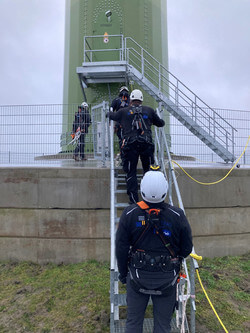News Release from ENERTRAG AG
Wind Industry Profile of
ENERTRAG Operation takes over technical management of the Krummendeich wind energy research park
Krummendeich (renewablepress) - How can wind be used most effectively to generate electricity? What do the turbines need to look like and can wind turbines actually be quieter? The Krummendeich Wind Energy Research Park in the district of Stade will be investigating these questions scientifically in future. The operator is the German Aerospace Center (DLR). The technical service provider ENERTRAG Operation won a public tender for the technical and commercial management and will be responsible for this for the next few years. Commercial management will be handled by partner GP JOULE Service.
WiValdi at the Krummendeich Research Park
The WiValdi research park (www.forschungspark-windenergie.de) is located at the Krummendeich site in the district of Stade in Germany, directly at the mouth of the river Elbe. Steady winds from the main wind direction west-southwest characterize the location of the research park. Two wind turbines were deliberately built one behind the other for research purposes. OPUS 1 and OPUS 2 are two identical Enercon E-115 EP3 wind turbines, each with an output of 4.26 MW, a height of 150 meters and a rotor diameter of 116 meters. Each turbine has around 1,300 sensors that provide detailed information, particularly about the rotor blades. These turbines are unique worldwide in their comprehensive measurement technology, which extends from the base to the tip of the blade. In addition to the permanently installed sensors, further sensors can be added to validate and compare data.
For research purposes, the spatial arrangement of the two wind turbines is a welcome field for collecting data, as it is important to install as many turbines as possible in the smallest possible space in order to achieve the expansion targets for wind energy in the future. The measurement of the direct wake behind the first turbine and the power measurements of the second turbine in conjunction with the metereological measurements are particularly interesting. This provides information on how efficient the turbines can be when they are installed as close together as possible.
Technical operations management monitors both the performance and the acoustics of the research facilities. In addition to some noise reduction measures on the rotor blade, which can be achieved via the design, profiles or edge modification (for example with serrated edges), it is primarily a matter of clever control.
Andre Reichert, Head of Operational Services at ENERTRAG Operation, explains: "The challenge is to operate the plants in such a way that the highest possible output can be achieved during and despite the research campaigns. This must be supported by skillful operational management. Optimum cooperation between researchers, monitoring, operations managers and our Powersystem operations management software is crucial here."
Research focus: Measurement of the turbulent wake
The configuration of the two wind turbines (one behind the other in the main wind direction), which is unfavorable from a commercial operators point of view but interesting from a research perspective, allows for investigations and experiments in the wake. In order to record the properties of the turbulent wake in detail, a total of five meteorological measuring masts have
been erected on the research park. A 150 meter high, IEC-compliant measuring mast is located in the main wind direction in front of OPUS 1. The sensors on this measuring mast accurately record the incoming wind field. As soon as the wind field hits OPUS 1, a complex, turbulent wake is created.
This wake is recorded by the measurement mast array, consisting of three measurement masts (100 m, 150 m and 100 m), which is positioned directly in front of OPUS 2 in the main wind direction. The array allows the turbulent wind field to be recorded over the entire rotor area of OPUS 2 before it hits OPUS 2. With this configuration, it is possible to investigate the effects of
the wake and to validate methods for reducing or deflecting the wake to increase the effectiveness of the entire wind farm.
- Source:
- Enertrag AG
- Author:
- ENERTRAG Operation

